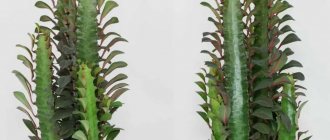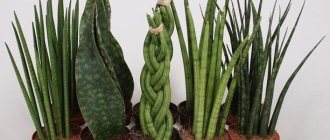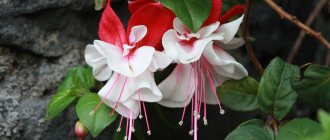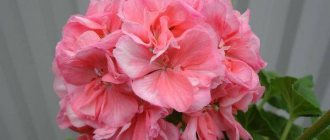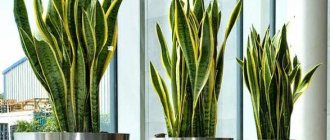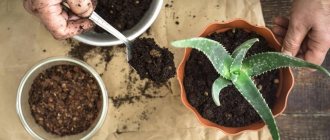» Signs » Pike tail in the house - what the signs say
0
2221
Article rating
Pike tail (Sansevieria) is almost completely easy to care for and fits perfectly into the interior. Due to the elongated leaf plates, it was also given names - Devil's Tongue, Indian Sword and Snakeskin. There are many signs and superstitions about this plant. Let's see if you can grow it at home.
Description of Sansevieria
“Pike tail” is one of the common names of the plant. Others are “snake skin”, “mother-in-law’s tongue” and “wolf tail”.
Sansevieria received its scientific name in honor of the Prince of San Severo Raimondo di Sangro, who lived in the 18th century and invented color printing and many other useful things.
The flower was brought to Europe from Southeast Asia and from the shores of the African country of Congo. The number of plants belonging to the genus Sansevieria exceeds 50.
The secret to the popularity of the pike tail is simple - incredible beauty combined with ease of care. A distinctive feature of this perennial succulent is its striped, smooth, dark green leaves that grow from the very roots and reach 1 m in height. White or yellow patterns can be located both along the leaf plate and across it.
There is often a sharp tip at the top of the leaf. Despite the possible inconvenience, you should not break off the thorn under any circumstances, as this will slow down the growth of the plant. With its shape, the sheet can resemble a saber, a pencil, and even a spoon.
With proper care at home and sufficient lighting, Sansevieria begins to bloom. This usually happens in the spring, when a peduncle with small and white buds emanating the aroma of vanilla appears from a rosette of leaves.
In the interior of an office or home living room, it looks good in composition with other indoor plants. An excellent option is several plants planted in a row in a long and low pot.
Diseases and pests
Mealybug
No matter how unpretentious a flower may be, sometimes inattention to it can provoke diseases that will have to be treated.
- The main “scourge” of a pike tail is excess moisture . As a result, the roots rot and the flower begins to disappear. The main symptom is yellowed leaves. Treatment consists of removing the flower from the container, removing damaged roots and treating the remaining ones with antifungal drugs. After this, the roots are dried for about 7 days and the mother-in-law’s tongue is planted in new soil.
- Sometimes a plant can get sick from excessive growth. The rather tall “tongues” of the flower, having no support, begin to fall and then wither.
Pests also cause inconvenience - root scale insects and mealybugs . This can be recognized by pale brown or whitish spots on the leaves. You can remove insects with a cloth soaked in alcohol, and then apply insecticidal preparations.
The benefits and harms of sansevieria
The pike tail is loved because it perfectly purifies the air. According to NASA research, this flower has the rare property of absorbing carbon dioxide and other substances released from plastic.
Before placing a plant in a child's room, you need to make sure that children or pets will not taste it. The fact is that some varieties, which are completely safe in contact with skin, cause nausea and vomiting when ingested.
In folk medicine, pike tail is used to treat open wounds, burns and inflammations.
It is used in the same way as aloe: pieces of leaves are applied to damaged areas of the skin.
Magic properties
Any flower carries energy that in a certain way affects various areas of human life. Pike tail is no exception. Among its magical properties are the following:
- filters negative vibes, helps get rid of the adverse effects of deceitful and envious guests.
- strengthens willpower.
- helps overcome apathy and increases determination.
- is an excellent assistant in educational processes and work, activates imagination.
- restores the aura of love between partners.
- calms the nervous system, reduces fatigue.
- relieves migraines, normalizes blood pressure.
- attracts financial well-being and luck to its owner into the house.
- harmonizes love relationships.
- helps to become decisive, strengthens friendships, and renews trust between loved ones.
Pike tail (sansevieria): varieties
Varieties of Sansevieria differ significantly from each other in their appearance: leaf shape, color of stripes and size - from a giant cylinder to a small Hunny. In order not to get lost among such diversity, you should familiarize yourself with the most common of them.
Sansevieria three-striped, the same one that is called the “pike tail”, has dark green leaves lined with transverse light stripes. The height of the leaves reaches 120 cm, and their width is 10 cm. The green edges of the leaf, tapering towards the top, form a spike.
Sansevieria three-lane
Sansevieria cylindrica (cylindrica) received its name due to its thick paired leaves. Color – gray-green with transverse dark stripes. The largest specimens grow up to two meters in height.
Sansevieria cylindrica (cylindrica)
Sansevieria Twister is more of a forming method than a variety. The leaves of young plants are braided in the form of a braid. The length of this “hairstyle” ranges from 30 cm to 1 m.
Sansevieria Twister
Sansevieria Laurenti is a variety that has become the “parent” of many other species. The main feature is the contrasting yellow edges. The color of the long leaves is heterogeneous - dark stripes alternate with light ones.
Sansevieria Laurenti
Sansevieria Hanni (low-growing) differs from the previous ones in short dark green leaves, bent in different directions. It has a very modest size - no more than 30 cm. This type of pike tail was patented relatively recently, in 1941, by a scientist named S. Khan.
Sansevieria Hanni (low growing)
Sansevieria Golden Honey was patented a little later, in 1953. In appearance it resembles the Hanni variety, but the color is slightly different - the edges of the leaves are decorated with yellow stripes.
Sansevieria Golden Honey
Sansevieria Silver Hanni is another derivative of Hanni. Identical in rosette shape, but the leaf has silver veins and a dark edge.
Sansevieria Silver Honey
Sansevieria zeylanica is famous for its spectacular appearance, despite its medium size (30-150 cm). Characteristics: wide leaves with silver wavy stripes and specks. Some botanists classify Zeylanica as a variety of Sansevieria three-lane.
Sansevieria zeilanica
Sansevieria Silver Queen is a variety of piketail with matte silver leaves. The pattern on the plate is practically not expressed, there is only a thin dark edging. It is considered fast growing, but does not bloom.
Sansevieria Silver Queen
Sansevieria Black Dragon is a rare variety with glossy dark, almost black foliage. The maximum height of the flower is no more than 25 cm. The leaf shape is oval, with pointed ends and a spike at the end.
Sansevieria Black Dragon
Sansevieria Futura is a low-growing but noticeable variety. The leaf length does not exceed 30 cm. The bright, rich color of the leaves with longitudinal yellow stripes and dark specks always attracts attention.
Sansevieria Futura
Sansevieria Moonshine is a new addition to the piketail family. Outwardly, with its gray-green uniformity, it resembles Silver Queen, but differs in the length of the leaf (no more than 35 cm).
Sansevieria Moonshine
Sansevieria bonselensis is an exotic specimen with thick, voluminous leaves arranged in a fan. Height – 10-30 cm. The color indicates its relationship with the cylinder.
Sansevieria bonselensis
Sansevieria gold flame. If in most varieties the yellow stripes are located along the edges of the leaf and serve as an edging, then in these “tails” they occupy a good half of the leaf. The sizes are average - about 30 cm.
Sansevieria gold flame
How to attract prosperity using Mother-in-Law's Tongue
“Mother-in-law’s tongue” is a peacemaker plant that harmonizes the situation in the family and helps people find a common language in the most seemingly hopeless situations. The flower neutralizes any negativity in relationships between people, helps the sick get better and protects against the evil eye.
- Sansevieria leaves can serve as a declaration of love. The one who received such a gift should put it under his pillow and sleep on it for three nights.
- If there are often strangers in the house, you should place the flower exactly where guests communicate with the owners. Mother-in-law's tongue will make people more benevolent, protect them from damage, and those guests who have bad intentions are unlikely to cross the threshold of this house again.
- A sick person needs to stroke the plant more often, “giving” his illness to it. If a baby is sick, his mother can do this for him.
- If a husband and wife quarrel, the “Mother-in-Law’s Tongue” growing in the marital bedroom will help you forget the differences. This method will work if the flower is presented by the parents of either spouse.
Unmarried girls can even tell fortunes in “Mother-in-Law’s Language.” To do this, you need to choose a piece of paper, guess the name of the young man you like and follow this sheet for a month. If the leaf does not fall off or wither, it means that the girl can count on the tender feelings of her chosen one.
A sensitive and kind Sansevieria can become a real guardian of the family hearth if you treat it like a living being, care for it, talk, and be attentive to changes. Those who lack family happiness should think about adding this plant to their home. Sansevieria has many subspecies, and you need to choose the appropriate variety of the “Mother-in-Law’s Tongue” flower from the photo, study the signs and get a real green “barometer” that will predict the weather in the house.
Coleus: signs and superstitions about the fiery flower
Flower “Women's Happiness”: signs and superstitions associated with it
Home care
Pike tail is one of the most undemanding plants to care for. To make a flower comfortable, you only need to know the basic rules.
One of them is that Sansevieria does not like to be moved from place to place.
Lighting
Sansevieria feels equally good both in a sunny corner and in a shaded one.
But it should be remembered that in the absence of light for a long time, variegated varieties lose their brightness.
It is better to protect the plant from direct rays, as this can cause burns. In winter, artificial supplementary lighting is recommended. In spring and summer, the pike tail can be taken out into the fresh air, but the place is chosen in such a way that raindrops do not fall on the leaves.
Temperature
The flower is completely indifferent to temperature changes; not a single draft will harm sansevieria. In summer, the optimal thermal regime is from +18° to +25°С, in winter +14…+16°С. At air temperatures below +10°, the plant will not die, but will stop growing.
Watering
Like other succulents, it does not tolerate excess moisture. It is enough to water the pike tail once a week in the summer and once a month in the winter. An important point is that you need to carefully ensure that water does not get into the middle of the outlet, as this will lead to rotting.
Top dressing
Even the most unpretentious herbal pets need vitamins, and therefore we must not forget about fertilizers. They feed the mother-in-law's tongue three times during the summer (once a month). At the same time, a 50% solution of mineral fertilizer for cacti is added (with a predominance of the potassium-phosphorus component).
Transplantation and soil
Since the root system of the pike tail does not grow in depth, but to the sides, the pot must be wide and strong enough to withstand the pressure.
It is imperative to make a drainage layer. The ideal soil consists of leaf, turf soil and sand in a ratio of 2:2:1. Young plants are usually replanted once every one and a half to two years, older plants - once every three years. If the procedure is carried out in the spring, then it is combined with dividing the bush.
Feng Shui
According to Eastern teachings, large rooms, preferably with a high degree of traffic, are most suitable for flowers.
Ideal locations for Pike Tail in a residential building:
- Work area - will intercept a larger amount of harmful radiation, protect envious and scandalous colleagues from negative energy flows.
- Kitchen - will absorb the bulk of the waves emanating from household appliances.
- Hall and living room - acts as a magnet for negativity, and the ill-wisher will experience discomfort and will soon leave the area.
- School class - will help students better assimilate new information.
- The toilet/bathroom is an unusual location option, but it is believed that negative fluids from the house will leave along with the wastewater.
Reproduction methods
There are several ways to obtain new specimens of Sansevieria.
Side shoots
With this method, the shoot is separated from the parent plant. To do this, the rhizome that connects the baby to the “mother” is cut with a knife. The cut area is sprinkled with crushed coal, then planted in a separate container with fresh soil. You need to handle the newcomer with care: when watering, avoid getting liquid on the leaves, and also do not feed.
Leaf
For such propagation, old lower and healthy leaves are taken. They are cut into pieces of 5-10 cm and left for a couple of days at room temperature. After such drying, the cuttings are planted vertically in damp sand or peat to a depth of 2 cm. It is very important here not to confuse the top and bottom of the piece, because if planted on the wrong side, the roots will not grow. The distance between young tails is 2-4 cm.
The top of the “bed” is covered with cans or plastic bags, which must be removed once a day to provide ventilation for the cuttings. Water as needed through a tray. Two to three months later, after the roots and stems appear, the plants are picked. This method is only suitable for varieties with green leaves; variegated stripes are not inherited in this way.
Dividing the rhizome
By dividing the rhizome, adult specimens with a developed root system are propagated. It is necessary to divide the rhizome so that each piece contains at least one bud. The sections are treated with fungicide or crushed coal, then planted in the ground.
Transfer
With proper care of the plant, it grows quickly and the flower pot becomes small. Transplanting a pike tail is a simple procedure, but requires care:
- To begin with, the flower is removed from the old container along with the soil. To avoid damaging the plant, the soil should be moistened first.
- Having freed the roots from the ground, check them for the absence of rot. If everything is fine, you can plant it in a new pot.
- The flower pot is first doused with boiling water and dried. And only then drainage is placed on the bottom (river pebbles, expanded clay balls, etc.).
- Having poured new soil into the container (the composition is described above), plant sansevieria in it, lightly pressing the roots into the soil, and immediately water it.
A new flower pot is placed in the place of the previous one and the development of the plant is monitored, trying not to miss the moment if it suddenly gets sick.
Beautiful and useful
Following the Asian and African healers who widely used pike tail in their practice, the beneficial properties of this plant were also noticed in our country. Saponins (glycosides of plant origin) contained in its leaves have anti-inflammatory and mucolytic, adaptive and immunostimulating effects. In addition, scientists have found that sansevieria significantly reduce the number of pathogenic microorganisms in the air of the room where they are located, and are also able to reduce the content of harmful synthetic substances such as trichlorethylene and benzene.
Tips for proper use of the plant
Recommendations for the correct use of Sansevieria are presented in the table.
| Disease | Recipe |
| Cystitis, inflammation of the female reproductive system | Preparation of tincture: - adding crushed raw materials to the glass (1/3 of the container). - pouring vodka over the component. - tight closure of the container. - installation in the refrigerator. - keeping for 3 weeks. - strain through a fine sieve. Method of administration: 1 tablespoon 2 times a day, after meals. The duration of treatment is 14 days. The break before the next course is 3 weeks. The tincture is stored in the refrigerator. |
| Otitis | The initial stage is squeezing the juice from the leaves of the plant. Application: heating the liquid in a water bath, instilling in the ears (1-2 drops). Apply several times a day. |
| Acne, purulent skin rashes | Method of application: applying a cotton pad soaked in the juice of the culture to the sore spots. The juice is slightly warmed up beforehand. The second treatment option is to apply cut leaves to the affected skin. |
| Boosting immunity | A decoction prepared from the roots of the flower is used. Cooking method: - Thorough rinsing of the roots. — drying of prepared raw materials. - pouring boiling water. - infusion for 15 minutes. - straining. Method of administration: 1 tablespoon 3 times a day. The decoction is consumed before meals. |
| Treatment of depressive disorders | |
| Improved blood circulation | |
| Diseases of the gastrointestinal tract | Step-by-step preparation: - cutting two leaves. - pour 1.5 liters of hot water. - boil for 5 minutes. - infusion process (30 minutes). The resulting decoction is used for an enema (once a day). |
Sansevieria is a plant with many medicinal properties. Compliance with recommendations for proper use is the key to successful treatment of many diseases.



